Sourdough English Muffins
Sourdough English Muffins are surprisingly easy to make and soooo much better than store bought. The active starter in the dough makes the flavor and texture extra special. The recipe takes several hours, but there is very little hands-on time. Stock up the freezer for future breakfasts.
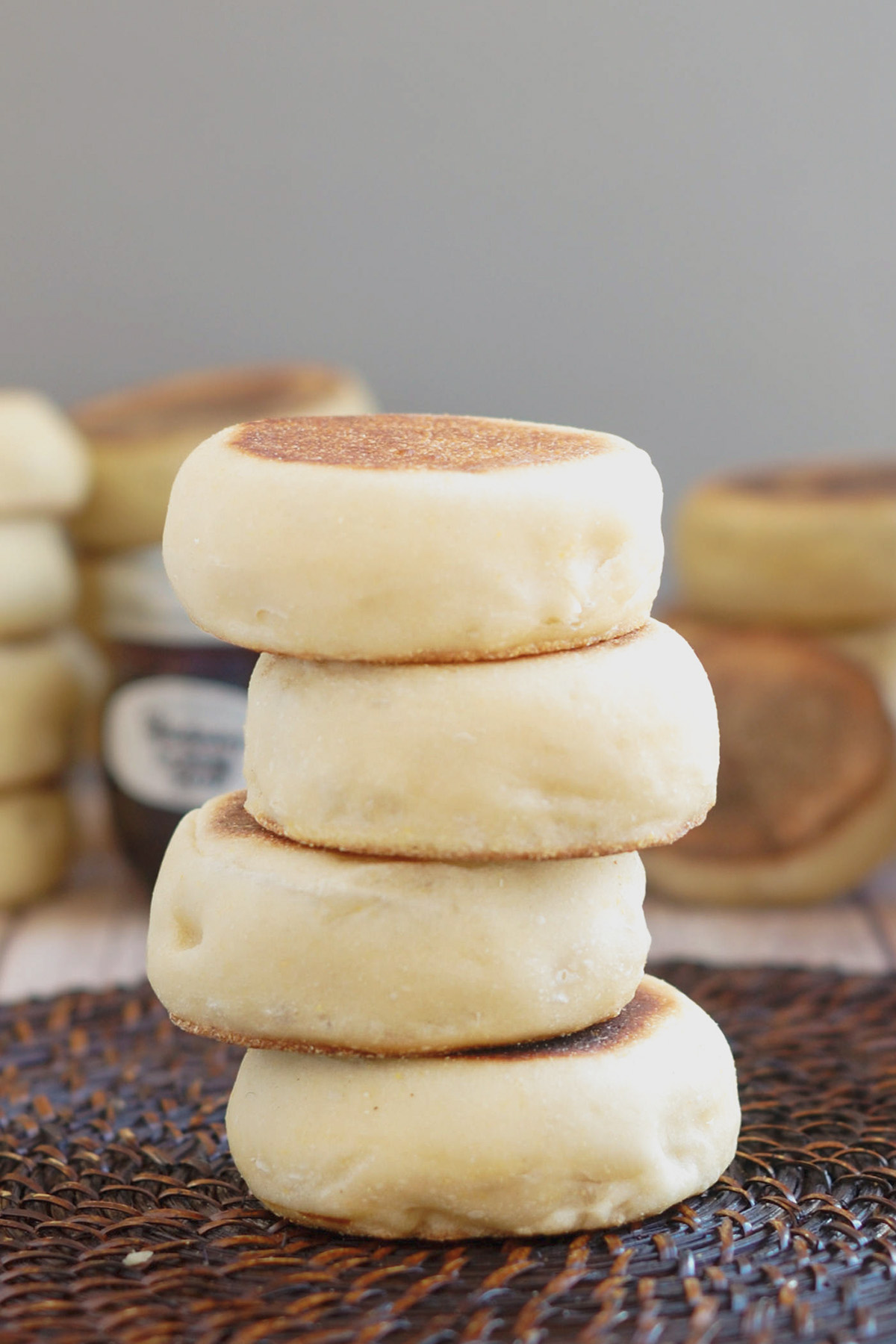
Table of contents
About this recipe
English Muffins are always toasted before eating. So use your starter to make Sourdough English Muffins for a later date. This is a perfect “make ahead and freeze” recipe.
If you don’t already have one, I can show you how to make a sourdough starter and how to feed a sourdough starter.
Ingredients
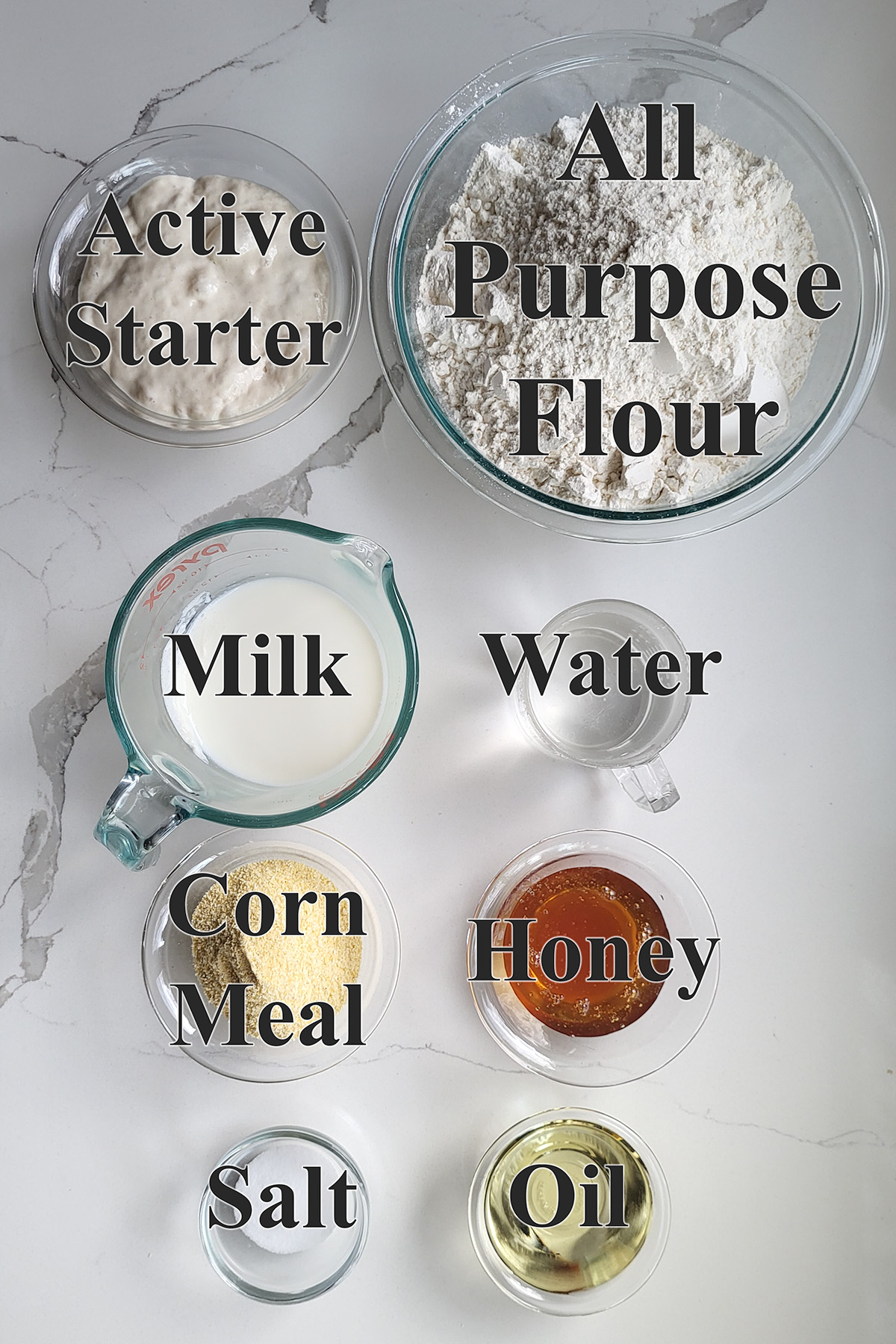
Ingredient Notes
- Sourdough Starter – The recipe was developed using 100% hydration starter. If your starter has a different hydration percentage you will need to adjust the amount of water or flour in the recipe.
- Unbleached All Purpose Flour – Medium content all purpose flour makes a dough with enough gluten for the muffins to rise. You may replace a cup of the all purpose flour with whole wheat or rye flour for whole grain flavor.
- Honey – You can substitute 1/4 cup (2 oz) of granulated sugar if you don’t have honey.
- Corn Meal – Rolling the dough on cornmeal gives the muffins the classic cornmeal dusted bottom crust. You can use flour for rolling if you don’t have cornmeal.
Process Photos
See the recipe card for detailed measurements and instructions.
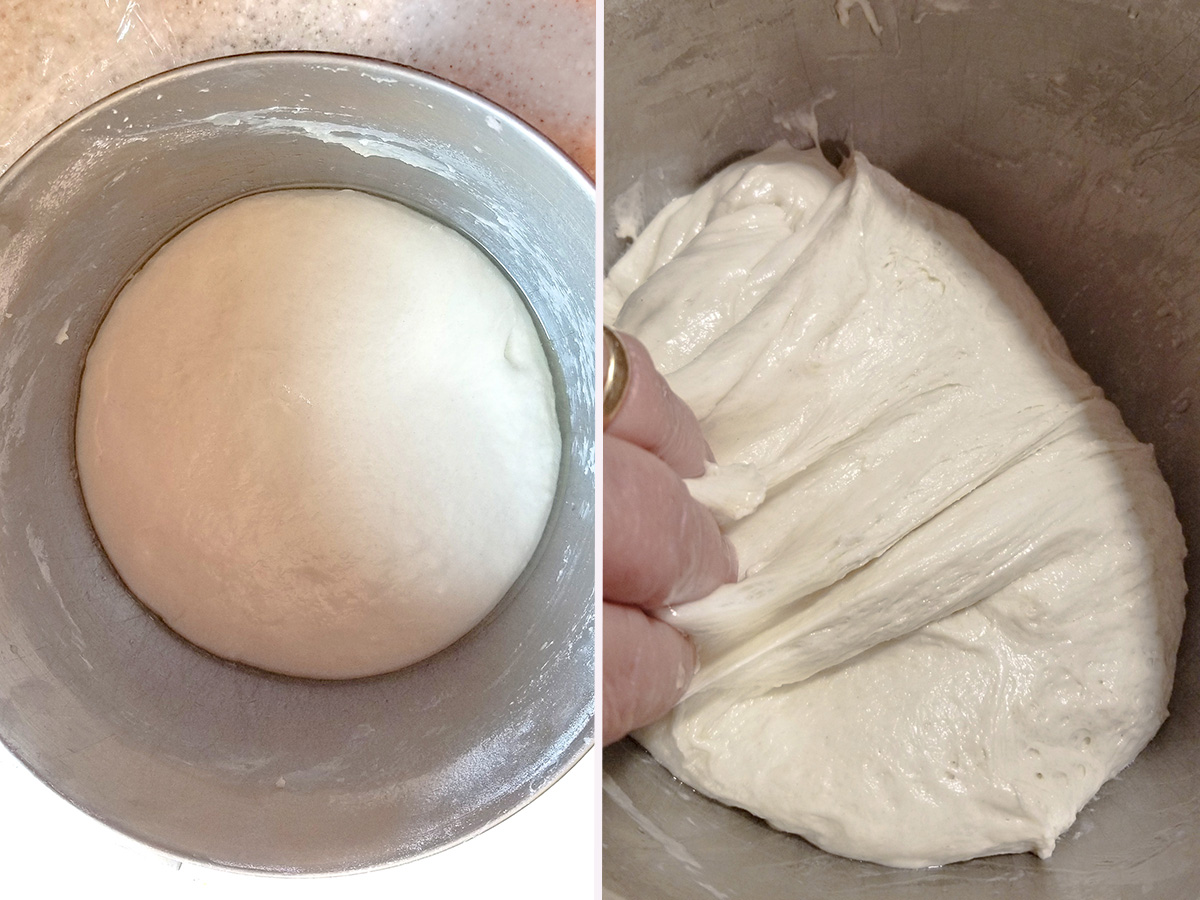
- After the dough is mixed set it aside at room temperature to ferment.
- Every hour fold the dough to develop the gluten and redistribute the yeast.
- The dough is ready when it is lively, light and elastic. This should take 3-5 hours.
- At this point the dough can be refrigerated for up to 2 days or you can proceed with cutting the muffins.
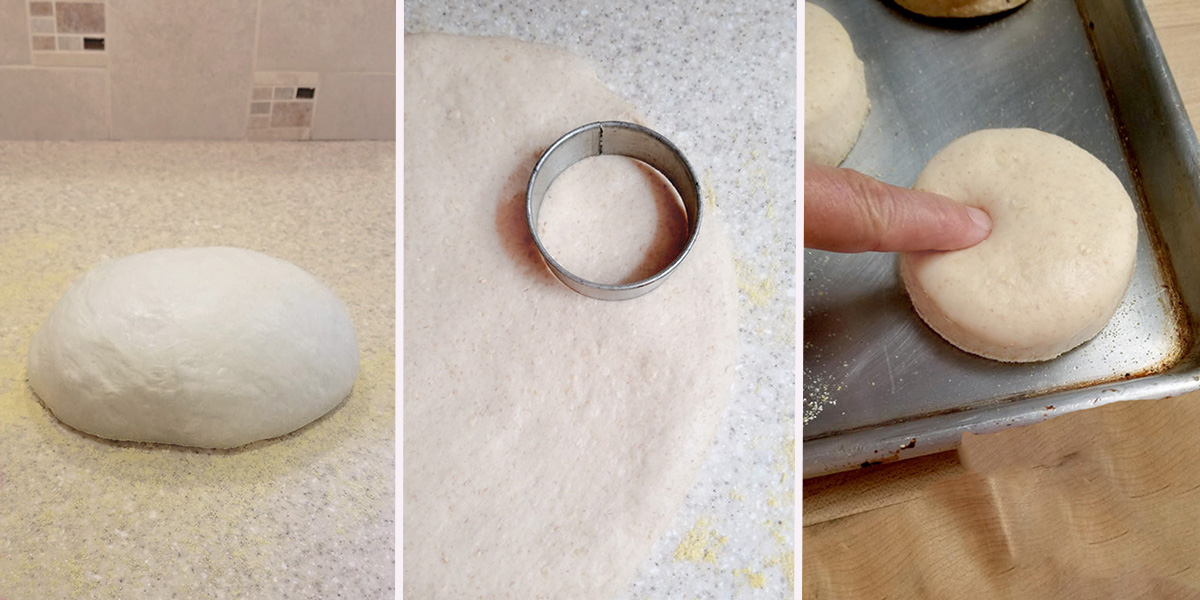
- Roll the dough to 1/2″ thick on a cornmeal dusted surface.
- Cut the muffins using a 3 – 3 1/2″ cutter. Line the muffins on a sheet pan. At this point you can wrap the tray and refrigerate overnight to bake the next day.
- Allow the muffins to rise for 1-2 hours. The rise time will vary depending on the temperature of the dough and the ambient temperature in the room.
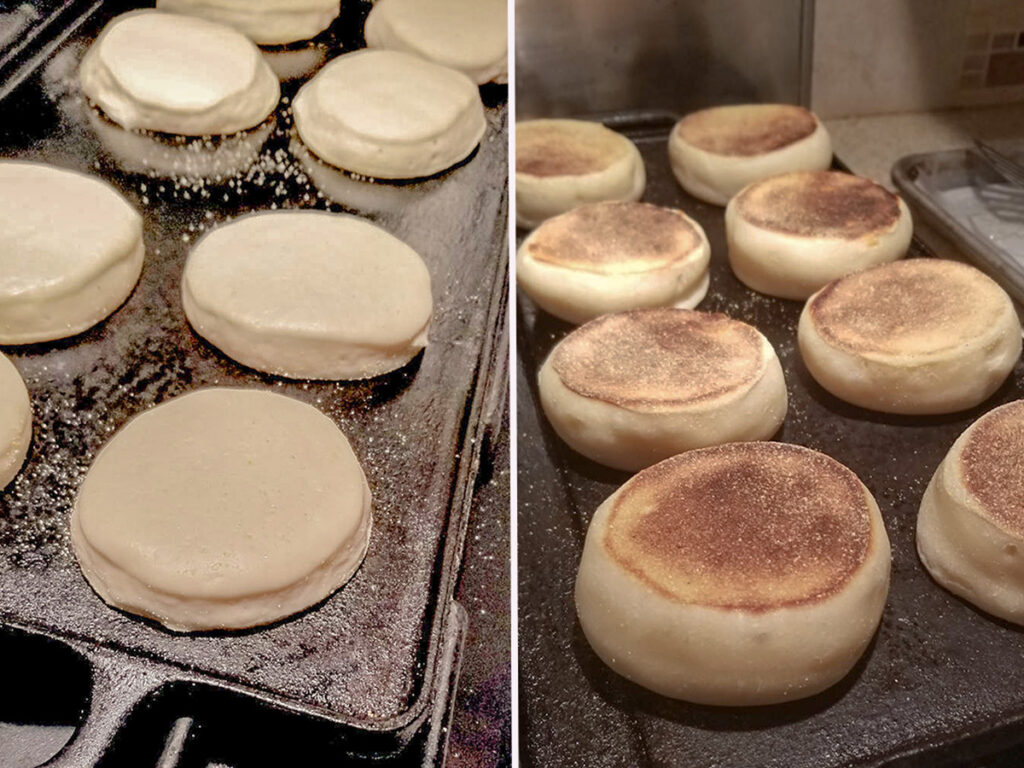
- Preheat a cast iron griddle or skillet over medium high heat.
- Set the muffins, cornmeal side down, on the pan. Leave 1″ space between muffins. Cook until the muffins rise up, brown on the bottom and the sides are mostly set, about 6-8 minutes. Adjust the heat as needed to keep a constant temperature.
- Flip the muffins and bake until the other side is golden brown and the sides are set, also about 6-8 minutes.

- Completely cool the muffins on a rack before packing into a freezer bag.
How to Serve Sourdough English Muffins

- Sourdough English Muffins should always be toasted before serving.
- To get the best texture don’t slice it with a knife! Use a fork to split the muffin.
- Fork-splitting forms the “nooks and crannies” that hold lots of melted butter.
Storage
- Fresh Sourdough Muffins will keep at room temperature for one day.
- For longer storage, pack the muffins into freezer bags and freeze up to 3 months.
- Microwave a frozen muffin for 10 to 20 seconds. Fork split the muffin, toast and serve.
I know you hate to throw away that sourdough discard. Check out these recipes that use sourdough discard.
More Sourdough Recipes:
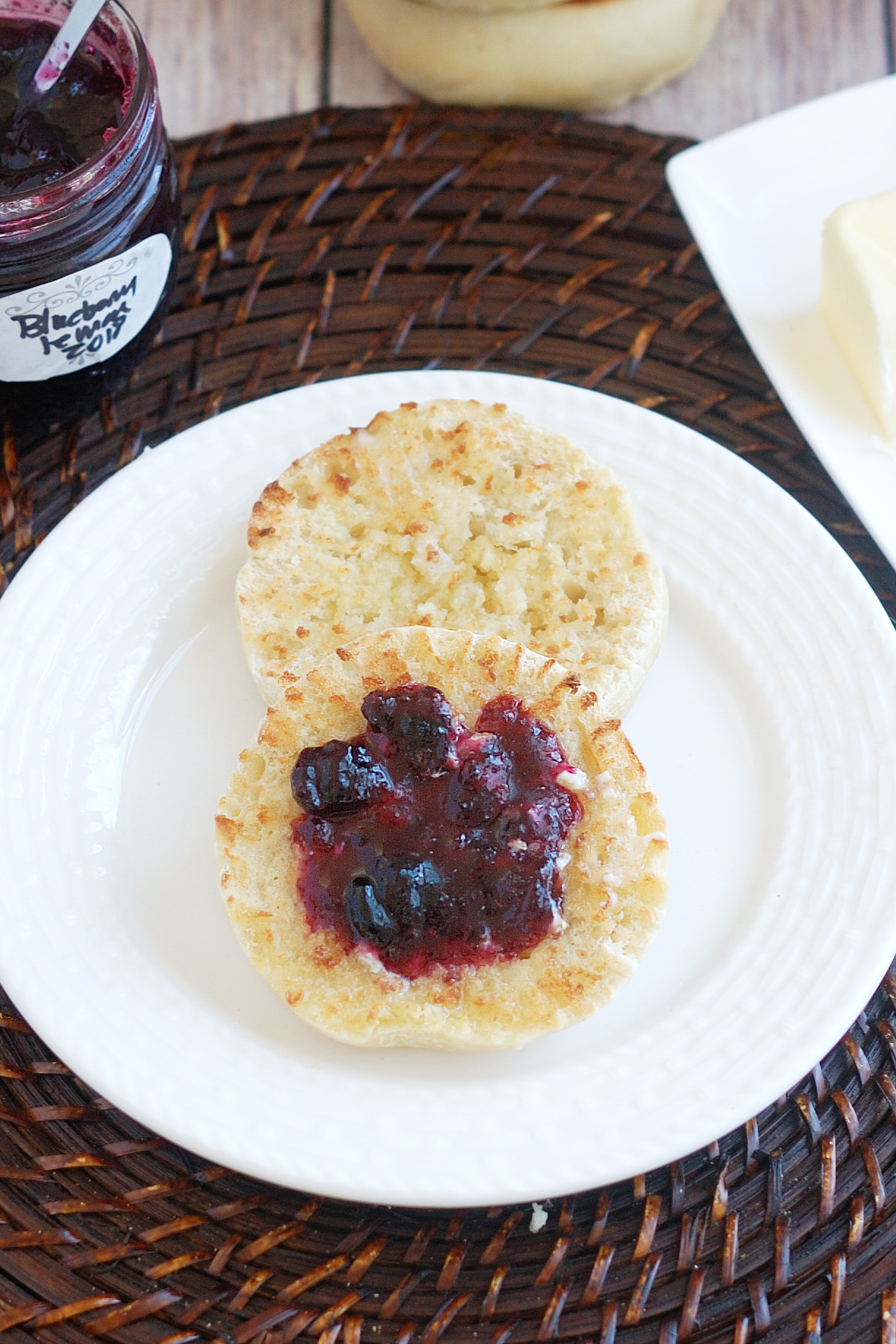
If you love this recipe as much as I do, please leave a 5-star review.
Sourdough English Muffin Recipe
Ingredients
- 8 oz active sourdough starter (1 cup, 100% hydration)
- 6 oz warm water (¾ cup)
- 8 oz whole milk (1 cup, scalded and cooled.)
- 25 oz unbleached all-purpose flour (5 cups, see note)
- 3 oz honey (¼ cup)
- 2 oz vegetable oil (¼ cup)
- 2 teaspoons salt
- cornmeal (for rolling)
Instructions
- Combine 8 oz active sourdough starter, 6 oz warm water, 8 oz whole milk and 2 cups (10 oz) of the flour in the bowl of a stand mixer or a large mixing bowl. Mix on low speed until combined. Cover the bowl and set aside for 30 minutes.
- Add 3 oz honey, 2 oz vegetable oil and 2 teaspoons salt and mix to combine. Switch to the dough hook if using a stand mixer. Add the remaining 3 cups (15 oz) flour and knead about 5 minutes or until the dough clears the sides of the bowl and clings to the hook. If mixing by hand, add flour until you can no longer stir, then turn the dough out onto a floured surface to finish by hand.
- Transfer the dough to a lightly oiled bowl, turning once to coat the dough. Cover the bowl and set it aside at room temperature. After 60 minutes uncover the bowl, lift one side of the dough over into the middle of the dough. Repeat with the other three sides of the dough then flip the dough over. Cover the bowl and after 60 minutes repeat the procedure. Cover the bowl and after 60 minutes repeat the procedure one last time. By now the dough should be lively, elastic and airy. If the dough is still sluggish give it another hour or two at room temperature. At this point the dough can be refrigerated for up to 2 days.
- Turn the dough from the bowl and knead briefly to form a smooth ball. Lightly sprinkle your work surface with cornmeal. Roll the dough to 1/2” thick. Cut muffins with a 3” biscuit cutter. Reroll the scraps and continue cutting until all the dough is used. You should get about 16 muffins. Place the muffins on an ungreased baking sheet. Cover the pan. (At this point the muffins can be refrigerated overnight and baked in the morning or continue to finish the muffins the same day.) Let the muffins rise until almost doubled in volume, about 1 hour.
- Preheat a griddle or cast-iron pan over medium-high heat. Reduce the heat to medium-low. Set the muffins, cornmeal side down in the pan. Place as many muffins as will fit in the pan with a 1" space between. "Bake" the muffins for about 6-8 minutes until the bottom is deep golden brown. Flip the muffins and bake until the other side is nicely browned. Keep an eye on the heat so the muffins don't burn. Adjust the heat as needed. Cool on wire rack. To serve, split and toast.
Would you like to save this recipe?
As an Amazon Associate and member of other affiliate programs, I earn from qualifying purchases.



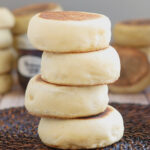





Hi Eileen! I’m from Argentina and just a few weeks ago I dived head first into the sourdough world. I came across your blog and every recipe looks amazing, can’t wait to try each and every single one. The weather is super hot here this time of the year, so some of them might have to wait. Thank you for sharing your recipes and tips!
Have Fun!
Can these be baked in the oven instead of the griddle or stovetop method?
Can the dough be mixed and rise in a bread machine on the dough setting!? I’ve made English muffins before like that but haven’t added sourdough yet.
I don’t have experience with a bread maker, but I don’t see why it wouldn’t work. Can you get into the machine to turn the dough while it’s fermenting?
I bake them for 15-20 minutes at 375F, to an internal temperature of 205F.
Does anyone else find that the dough turns to a sticky mess after the flour is all added? This is my second recipe and I was hoping that it wouldn’t happen again. I add all the flour, it looks great, then suddenly liquifies! Do I add more flour until it becomes a lovely dough ball or do I suck it up and hope for the best?
I’ve never had the dough come together and then “liquify”. Do you mix the dough by hand or with a stand mixer? Did you allow the sponge the 30 minute rest as instructed in step #1? That gives the gluten a head start. If working on a mixer the dough should cling to the hook and clear the sides of the bowl (it will stick to the bottom). If it’s not gathering on the hook you can sprinkle a little more flour, but give the mixer time to do bring the dough together on the hook. Sourdoughs will start out somewhat sticky (not so much a “dough ball”) but should become more elastic and cohesive during the long fermentation. Did you take the recipe through to the end or did you ditch the dough? Sourdough does behave a little differently than a regular dough so I would suggest you try finishing the recipe. Let me know if you have any other questions.
Can you use olive oil?
I had the same issue. I bake sourdough bread at home with great results and was excited to try this recipe. One thing i noticed is that it calls for 5 cups or 700 grams of flour. 5 cups is 600 grams so that could be the issue? I’m not sure but it was definitely much “wetter” than any sourdough I’ve ever done
A cup of all purpose flour (using the dip and sweep method) weighs 5 oz. I use the conversion of 28 grams per ounce. So 5 cups of all purpose flour weighs 25 oz. 25ozx28=700g. If you use the spooning method for measuring flour or fluff it up before measuring your cup of flour will weigh less. All my recipes assume 5 oz per cup of flour.
This has turned into a favorite. I’d been looking for more things to do with my sourdough starter and this was perfect. It puts the store bought English muffins to absolute shame. I’ve started adding a spice mix of cinnamon, ginger, nutmeg, and cloves to the dough for “pumpkin spice” and it has turned out really well.
Sourdough baking is kind of addicting, isn’t it? Here’s a link to a list of all my sourdough recipes. Have fun!
Hi there,
I’d like to make these with 1/2 the amount of honey. I am aware that the sweetener contributes to “feeding” the natural yeasts as well as flavour, so could I compensate (for using only 1/8 cup of honey) by allowing a longer time to rise? (I make sourdough bread for my family on a regular basis so I’m familiar with the use of sourdough starter but I’m wondering if you can advise me regarding using 1/2 the honey….
Thanks so much
Sheila
Yes, you can reduce the honey. The rise time is pretty variable anyway, as you know if you’re used to working with sourdough. Also, you may want to hold back a little of the flour as the honey also provides moisture. Just out of curiosity, why are you reducing the honey? Do you think they might be too sweet or do you just prefer less sugar in general.